This hardly seems like a frequently asked question to me, but our office manager, Lisa, was very happy to find a document in our company files titled “Equipment List”. It’s a list of inspection tools and equipment that my inspectors have. Unbeknownst to me, potential clients often ask what type of specialized inspection equipment our inspectors use. I never would have guessed. Home buyers are getting more and more savvy.
If this is a frequently asked question, the question and answer belongs on the FAQ Section of our web site, but I thought this might make for a good blog topic as well. While most home buyers probably don’t care about this list, the topic of which home inspection tools to purchase is a common thread on home inspection forums.
Oh, and by “good blog topic”, I really mean a topic that I would enjoy writing about. I love inspection toys tools. These are the specialized inspection tools that our inspectors use, along with my two cents on why.
- Infrared Camera – this is the most expensive and specialized tool that our inspectors use. My infrared camera of choice was the Flir i7, until I got my hands on a Flir E6. Now that one is my favorite. Our inspectors use one of these two cameras. I may write a blog post in the future, explaining why I think the E6 is the best IR camera for home inspectors.
- Moisture Meter – as I’ve blogged about in the past, the Protimeter Surveymaster moisture meter is the best moisture meter for home inspectors. All of the inspectors in my company use this one.
- Combustion Analyzer – this tool is primarily used for carbon monoxide testing at furnaces and boilers, but is also sometimes used at other appliances. We used to use the Bacharach Fyrite Tech 60, but we’ve switched over to using the Testo 310. The Testo 310 seems to be a far sturdier device, and the rechargeable internal battery seems to lasts forever.
 Combustible Gas Detector (aka “gas sniffer”) – we use this tool to help pinpoint the location of gas leaks primarily when our clients are watching, because it looks more professional than running our noses along gas pipes. If nobody is watching, I use my nose. A gas sniffer is also a good tool to use at boilers and gas fireplaces to check for exhaust gas leaks. In either case, the gas sniffer is never used as a tool to report anything, because it’s not a definitive test. Gas sniffers can give false positives. We simply use gas sniffers to find stuff faster. I’ve always used the TIF 8800A, and more recently the TIF 8900, but the Ridgid CD-100 is also a nice gas sniffer, according to George.
Combustible Gas Detector (aka “gas sniffer”) – we use this tool to help pinpoint the location of gas leaks primarily when our clients are watching, because it looks more professional than running our noses along gas pipes. If nobody is watching, I use my nose. A gas sniffer is also a good tool to use at boilers and gas fireplaces to check for exhaust gas leaks. In either case, the gas sniffer is never used as a tool to report anything, because it’s not a definitive test. Gas sniffers can give false positives. We simply use gas sniffers to find stuff faster. I’ve always used the TIF 8800A, and more recently the TIF 8900, but the Ridgid CD-100 is also a nice gas sniffer, according to George.
That makes up the list of specialized inspection equipment. Our list of not-so-specialized equipment is about ten times as long, and consists of stuff like a digital camera, flashlight, ladder, tool bag, and stuff like that. Of course, I have preferred model numbers for all of these.
For the record, the most expensive and fanciest equipment in the world will not equate to a good home inspection, and vice versa. They’re just tools, and should not be used as a reason to hire or not hire a home inspector.
